
Amphipoda is an order of malacostracan crustaceans with no carapace and generally with laterally compressed bodies. Amphipods range in size from 1 to 340 millimetres and are mostly detritivores or scavengers. There are more than 9,900 amphipod species so far described. They are mostly marine animals, but are found in almost all aquatic environments. Some 1,900 species live in fresh water, and the order also includes the terrestrial sandhoppers such as Talitrus saltator and Arcitalitrus sylvaticus.

Litopenaeus setiferus is a species of prawn found along the Atlantic coast of North America and in the Gulf of Mexico. It was the subject of the earliest shrimp fishery in the United States.
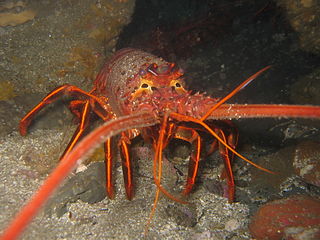
The California spiny lobster is a species of spiny lobster found in the eastern Pacific Ocean from Monterey Bay, California, to the Gulf of Tehuantepec, Mexico. It typically grows to a length of 30 cm (12 in) and is a reddish-brown color with stripes along the legs, and has a pair of enlarged antennae but no claws. The interrupted grooves across the tail are characteristic for the species.
Monoporeia affinis,, is a small, yellowish benthic amphipod living in the Baltic Sea, the Arctic Sea and the lakes of the Nordic countries.

Jassa is a genus of amphipods in the family Ischyroceridae, comprising the following species:
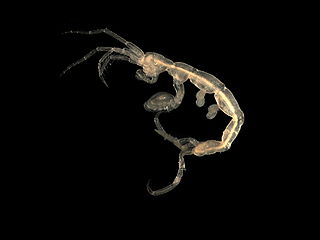
Caprellidae is a family of amphipods commonly known as skeleton shrimps. Their common name denotes the threadlike slender body which allows them to virtually disappear among the fine filaments of seaweed, hydroids and bryozoans. They are sometimes also known as ghost shrimps.

Jasus lalandii, the Cape rock lobster or West Coast rock lobster, is a species of spiny lobster found off the coast of Southern Africa. It is not known whom the specific epithet lalandii commemorates, although it may the French naturalist and taxonomer Pierre Antoine Delalande.

Talitrus saltator, a species of sand hopper, is a common amphipod crustacean of sandy coasts around Europe. The animal's typical "hopping" movement gives it its common name, and is produced by a flexion of the abdomen. In order to do this, it must stand on its legs and suddenly extend its abdomen from under its body. It can thus leap several inches into the air, although without any control over its direction. A great deal of scientific research has been carried out on the animal, to determine the environmental cues which it uses to control its behavior.

Lagodon is a genus of saltwater fish in the family Sparidae, the breams and porgies. It is monotypic, being represented by the single species Lagodon rhomboides, commonly known as pinfish. Other common names include pin perch, sand perch, choffer, and butterfish. It inhabits mostly subtropical shallow coastal waters of the Atlantic and Gulf coasts of the United States and Mexico.
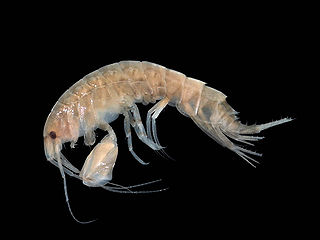
Abludomelita obtusata is a brown colored species of amphipod crustacean. It may grow up to 9 millimetres (0.35 in) long and lacks a rostrum. It lives in marine sediments of any grain size, but with a preference for a mud content of 10%–40%, around the coasts of the southern North Sea.

Bathyporeia elegans is a species of amphipod crustacean in the genus Bathyporeia which occurs in the northeastern Atlantic Ocean. It is unpigmented, and grows up to 6 millimetres (0.24 in) long.
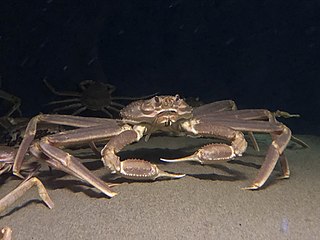
Chionoecetes opilio, a species of snow crab, also known as opilio crab or opies, is a predominantly epifaunal crustacean native to shelf depths in the northwest Atlantic Ocean and north Pacific Ocean. It is a well-known commercial species of Chionoecetes, often caught with traps or by trawling. Seven species are in the genus Chionoecetes, all of which bear the name "snow crab". C. opilio is related to C. bairdi, commonly known as the tanner crab, and other crab species found in the cold, northern oceans.
Urothoe marina is a species of small marine amphipod crustaceans in the family Urothoidae. It is found on and burrowing in coarse sediments in shallow coastal waters off northwestern Europe.
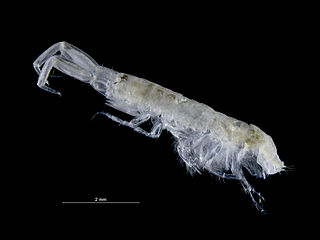
Monocorophium is a genus of amphipod crustaceans.

Nototropis falcatus is a species of amphipod crustacean. It is whitish in colour, with brown patches, and grows to a total length of around 7 mm (0.3 in). It lives on soft sediment such as fine sand at depths of 10 to 50 metres, from northern Norway to the west coast of Ireland, including the North Sea, and as far south as the southern Bay of Biscay.
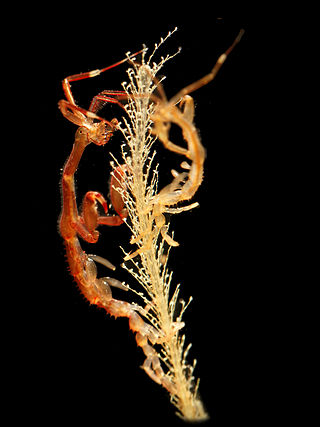
Caprella mutica, commonly known as the Japanese skeleton shrimp, is a species of skeleton shrimp. They are relatively large caprellids, reaching a maximum length of 50 mm (2.0 in). They are sexually dimorphic, with the males usually being much larger than the females. They are characterized by their "hairy" first and second thoracic segments and the rows of spines on their bodies. Body color ranges from green to red to blue, depending on the environment. They are omnivorous highly adaptable opportunistic feeders. In turn, they provide a valuable food source for fish, crabs, and other larger predators. They are usually found in dense colonies attached to submerged man-made structures, floating seaweed, and other organisms.
Jassa marmorata is a species of tube-building amphipod. It is native to the northeast Atlantic Ocean but has been introduced into northeast Asia. J. marmorata are greyish in colour with reddish brown markings. The can grow to a length of up to 10 millimetres (0.39 in). They are generally found in fouling communities and intertidal areas where they build tubes of detritus and algae fragments using silky mucus secretions. They are remarkable for having two distinct morphs of males with two different mating strategies. The 'major' morphs are fighter males, while the 'minor' morphs are sneaker males.
Paramoera walkeri is an amphipod of the genus Paramoera. It lives around Antarctica.
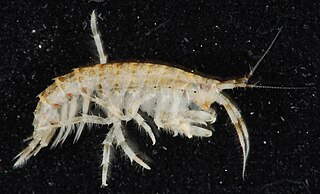
Gammarus mucronatus is a species of scud in the family Gammaridae. It is found in the coasts of the North American Atlantic seaboard and the Gulf of Mexico.
Crangonyx floridanus is a species of amphipod. Also known as the Florida crangonyx, Crangonyx floridanus is a small omnivorous, freshwater amphipod. These freshwater amphipods originated from North America. They have a high invasion potential due to their high growth rate and wide ecological amplitude. Their growth rates have a substantial effect on local populations of the natural communities. Native populations may be reduced or eliminated by this invading species.















